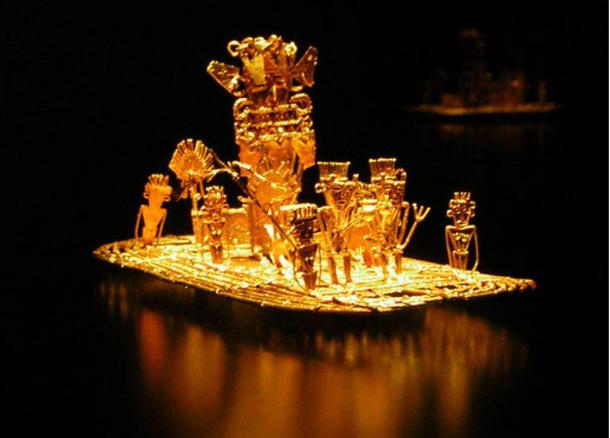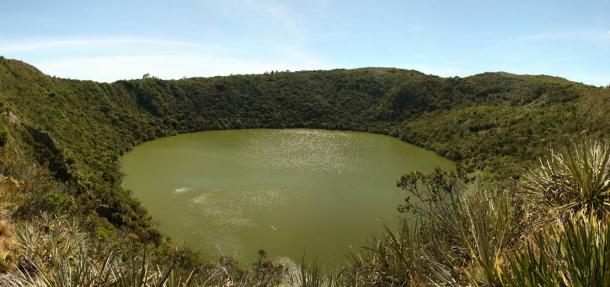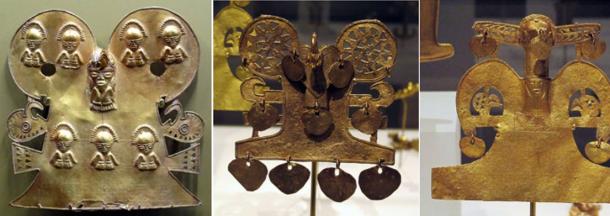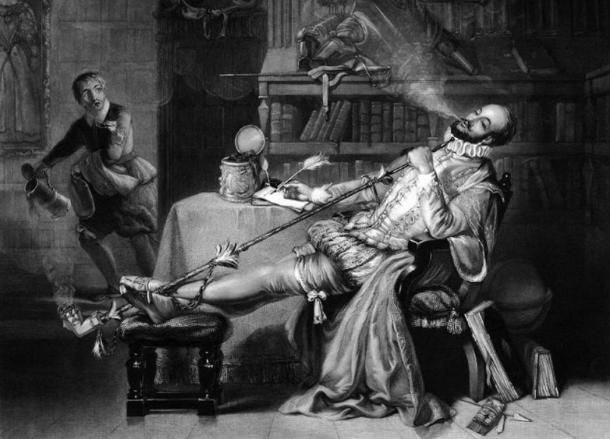For hundreds of years, treasure hunters and historians alike have searchedfor El Dorado, the lost city of gold. The idea of a city filled withgold and other riches has a natural appeal, drawing the attention of individuals from all over the world in hopes of discovering the ultimate treasure, and an ancient wonder. In spite of numerous expeditions around all of Latin America, the city of gold remains a legend, with no physical evidence to substantiate its existence.
The origins of El Dorado come from legendary tales of the Muisca
tribe. Following two migrations – one in 1270 BC and one between 800 and 500 BC, the Muisca tribe occupied the Cundinamarca and Boyacá areas ofColombia. According to legend, as written in Juan Rodriguez Freyle’s “El Carnero,” the Muisca practiced a ritual for every newly appointed king that involved gold dust and other precious treasures.

When a new leader was appointed, many rituals would take place before
he took his role as king. During one of these rituals, the new king
would be brought to Lake Guatavita, where he would be stripped naked,
and covered in gold dust. He would be placed upon a highly decorated
raft, along with his attendants, and piles of gold and precious stones.
The raft would be sent out to the center of the lake, where the king
would wash the gold dust from his body, as his attendants would throw
the pieces of gold and precious stones into the lake. This ritual was
intended as a sacrifice to the Muisca's god. To the Muisca, “El Dorado”
was not a city, but the king at the center of this ritual, also called
“the Gilded One.” While El Dorado is meant to refer to the Gilded One,
the name has now become synonymous with the lost city of gold, and any
other place where one can quickly obtain wealth.

In 1545, Conquistadores Lázaro Fonte and Hernán Perez de Quesada
attempted to drain Lake Guatavita. As they did so, they found gold along
its shores, fueling their suspicion that the lake contained a treasure
of riches. They worked for three months, with workers forming a bucket
chain, but they were unable to drain the lake sufficiently to reach any
treasures deep within the lake. In 1580, another attempt to drain the
lake was made by business entrepreneur Antonio de Sepúlveda. Once again,
various pieces of gold were found along the shores, but the treasure at
the depths of the lake remained concealed. Other searches were
conducted on Lake Guatavita, with estimates that the lake could contain
up to $300 million in gold, with no luck in finding the treasures. All
searches came to a halt when the Colombian government declared the lake a
protected area in 1965.

Nonetheless, the search for El Dorado continues, even without the
ability to search Lake Guatavita. The legends of the Muisca tribe, the
Gilded One and their ritualistic sacrifice of treasures have transformed
over time into today’s tale of El Dorado, lost city of gold. To many
individuals, El Dorado is a real city, and the desire to discover this
city is great. Whether led by greed, a desire for fame, or a desire to
unravel the mysteries of an ancient legend, these individuals have gone
on conquests in hopes of finding El Dorado. As the legends have shifted
and transformed, so has the location of El Dorado. Searches for the city
are not restricted to Colombia, or Lake Guatavita, where the Muisca
tribe practiced their rituals, but span all areas of Latin America.
Expeditions to find El Dorado have been conducted far and wide.

England’s Sir Walter Raleigh made two attempts to find El Dorado. In
1595, it was rumored that El Dorado could be found at Lake Parime in the
highlands of Guyana. Raleigh set sail, in hopes of discovering the lost
city, establishing an English presence in the Southern Hemisphere, and
creating an English settlement in the lad of Guyana. His desire to find
El Dorado remained strong, although he only discovered bits and pieces
of gold along the way. In 1617, Raleigh returned to South America with
his son, in hopes of finding El Dorado. His son was killed in conflict
with the Spaniards, and Raleigh did not find El Dorado on his second,
disastrous expedition. Upon his return to England, he was executed for
disobeying King James’ orders to avoid conflict with the Spanish.

Several expeditions to find El Dorado have been attempted since
Raleigh’s time, but none have been successful. Monks Acana and Fritz,
Don Manuel Centurion - Governor of San Thome del Angostura, and
entrepreneurs Nicholas Rodriguez and Antonio Santos, have all led
expeditions in hopes of finding the lost city. All have failed to find
the El Dorado, and the expeditions have led to the loss of hundreds of
lives – from those killed during the attempts to drain Lake Guatavita,
to those who perished while searching the landscape of Latin America.
The most recent attempt to find El Dorado occurred in 2000. The
Monastery of Santo Domingo was searching for underground Incan tunnels,
when they found a large tunnel beneath the Monastery, but no gold. Then
in 2001, Italian archaeologist Mario Polia discovered a document from
the 1600s that contained descriptions of a city that could potentially
be El Dorado. Within the area, located in Paratoari in Peru, tools and
evidence of manmade structures have been recovered, but El Dorado
remains a mystery.
Although the costly search for El Dorado has yet to yield any
evidence of an actual city of gold, the topic remains one of interest to
this day. Searches for El Dorado have spanned hundreds of years and
vast areas of Latin America, while costing a great deal of money, and
hundreds of lives. To some, it has become clear that the costs and risks
of continuing to search for El Dorado are not worth it, while others
remain determined to find the lost city of gold. Perhaps someday the
city of El Dorado will be discovered, and the riches rumored to be
contained within will be found, but for now, it remains a mystery
whether El Dorado is a real gold-filled ancient city, or simply a
legend.
Featured image: Golden vitives figures (known as tunjos),
Muisca-Chibcha culture — pre-columbian culture in the territory of
modern Colombia; Gold Museum, Bogotá, Colombia (Wikimedia Commons)
Sources:
The Legend of El Dorado – Historic Mysteries. Available from: http://www.historicmysteries.com/legend-of-el-dorado/
El Dorado Legend Snared Sir Walter Raleigh – National Geographic. Available from: http://science.nationalgeographic.com/science/archaeology/el-dorado/
El Dorado – Wikipedia. Available from: http://en.wikipedia.org/wiki/El_Dorado
El Dorado – Myths Encyclopedia. Available from: http://www.mythencyclopedia.com/Dr-Fi/El-Dorado.html
By M R Reese
The origins of El Dorado come from legendary tales of the Muisca
tribe. Following two migrations – one in 1270 BC and one between 800 and 500 BC, the Muisca tribe occupied the Cundinamarca and Boyacá areas ofColombia. According to legend, as written in Juan Rodriguez Freyle’s “El Carnero,” the Muisca practiced a ritual for every newly appointed king that involved gold dust and other precious treasures.

Portraits of rulers of Muisca (Wikimedia Commons)
When a new leader was appointed, many rituals would take place before
he took his role as king. During one of these rituals, the new king
would be brought to Lake Guatavita, where he would be stripped naked,
and covered in gold dust. He would be placed upon a highly decorated
raft, along with his attendants, and piles of gold and precious stones.
The raft would be sent out to the center of the lake, where the king
would wash the gold dust from his body, as his attendants would throw
the pieces of gold and precious stones into the lake. This ritual was
intended as a sacrifice to the Muisca's god. To the Muisca, “El Dorado”
was not a city, but the king at the center of this ritual, also called
“the Gilded One.” While El Dorado is meant to refer to the Gilded One,
the name has now become synonymous with the lost city of gold, and any
other place where one can quickly obtain wealth.

Muisca raft, representation of the initiation of
the new Zipa in the lake of Guatavita, possible source of the legend of
El Dorado. It was found in a cave in Pasca, Colombia in 1856, together
with many other gold objects. Dated between 1200 and 1500 BC. (Wikimedia Commons)
the new Zipa in the lake of Guatavita, possible source of the legend of
El Dorado. It was found in a cave in Pasca, Colombia in 1856, together
with many other gold objects. Dated between 1200 and 1500 BC. (Wikimedia Commons)
In 1545, Conquistadores Lázaro Fonte and Hernán Perez de Quesada
attempted to drain Lake Guatavita. As they did so, they found gold along
its shores, fueling their suspicion that the lake contained a treasure
of riches. They worked for three months, with workers forming a bucket
chain, but they were unable to drain the lake sufficiently to reach any
treasures deep within the lake. In 1580, another attempt to drain the
lake was made by business entrepreneur Antonio de Sepúlveda. Once again,
various pieces of gold were found along the shores, but the treasure at
the depths of the lake remained concealed. Other searches were
conducted on Lake Guatavita, with estimates that the lake could contain
up to $300 million in gold, with no luck in finding the treasures. All
searches came to a halt when the Colombian government declared the lake a
protected area in 1965.

Guatavita Volcanic Lagoon, Cundinamarca, Colombia,
the sacred lake and center of the rites of the Muiscas. Source:
BigStockPhoto.
the sacred lake and center of the rites of the Muiscas. Source:
BigStockPhoto.
Nonetheless, the search for El Dorado continues, even without the
ability to search Lake Guatavita. The legends of the Muisca tribe, the
Gilded One and their ritualistic sacrifice of treasures have transformed
over time into today’s tale of El Dorado, lost city of gold. To many
individuals, El Dorado is a real city, and the desire to discover this
city is great. Whether led by greed, a desire for fame, or a desire to
unravel the mysteries of an ancient legend, these individuals have gone
on conquests in hopes of finding El Dorado. As the legends have shifted
and transformed, so has the location of El Dorado. Searches for the city
are not restricted to Colombia, or Lake Guatavita, where the Muisca
tribe practiced their rituals, but span all areas of Latin America.
Expeditions to find El Dorado have been conducted far and wide.

Gold artifacts from the Muisca tribe of Colombia (public domain)
England’s Sir Walter Raleigh made two attempts to find El Dorado. In
1595, it was rumored that El Dorado could be found at Lake Parime in the
highlands of Guyana. Raleigh set sail, in hopes of discovering the lost
city, establishing an English presence in the Southern Hemisphere, and
creating an English settlement in the lad of Guyana. His desire to find
El Dorado remained strong, although he only discovered bits and pieces
of gold along the way. In 1617, Raleigh returned to South America with
his son, in hopes of finding El Dorado. His son was killed in conflict
with the Spaniards, and Raleigh did not find El Dorado on his second,
disastrous expedition. Upon his return to England, he was executed for
disobeying King James’ orders to avoid conflict with the Spanish.

Sir Walter Raleigh went on two expeditions to find
El Dorado. ‘Raleigh's First Pipe in England’ by Frederick William
Fairholt, 1859. (public domain)
El Dorado. ‘Raleigh's First Pipe in England’ by Frederick William
Fairholt, 1859. (public domain)
Several expeditions to find El Dorado have been attempted since
Raleigh’s time, but none have been successful. Monks Acana and Fritz,
Don Manuel Centurion - Governor of San Thome del Angostura, and
entrepreneurs Nicholas Rodriguez and Antonio Santos, have all led
expeditions in hopes of finding the lost city. All have failed to find
the El Dorado, and the expeditions have led to the loss of hundreds of
lives – from those killed during the attempts to drain Lake Guatavita,
to those who perished while searching the landscape of Latin America.
The most recent attempt to find El Dorado occurred in 2000. The
Monastery of Santo Domingo was searching for underground Incan tunnels,
when they found a large tunnel beneath the Monastery, but no gold. Then
in 2001, Italian archaeologist Mario Polia discovered a document from
the 1600s that contained descriptions of a city that could potentially
be El Dorado. Within the area, located in Paratoari in Peru, tools and
evidence of manmade structures have been recovered, but El Dorado
remains a mystery.
Although the costly search for El Dorado has yet to yield any
evidence of an actual city of gold, the topic remains one of interest to
this day. Searches for El Dorado have spanned hundreds of years and
vast areas of Latin America, while costing a great deal of money, and
hundreds of lives. To some, it has become clear that the costs and risks
of continuing to search for El Dorado are not worth it, while others
remain determined to find the lost city of gold. Perhaps someday the
city of El Dorado will be discovered, and the riches rumored to be
contained within will be found, but for now, it remains a mystery
whether El Dorado is a real gold-filled ancient city, or simply a
legend.
Featured image: Golden vitives figures (known as tunjos),
Muisca-Chibcha culture — pre-columbian culture in the territory of
modern Colombia; Gold Museum, Bogotá, Colombia (Wikimedia Commons)
Sources:
The Legend of El Dorado – Historic Mysteries. Available from: http://www.historicmysteries.com/legend-of-el-dorado/
El Dorado Legend Snared Sir Walter Raleigh – National Geographic. Available from: http://science.nationalgeographic.com/science/archaeology/el-dorado/
El Dorado – Wikipedia. Available from: http://en.wikipedia.org/wiki/El_Dorado
El Dorado – Myths Encyclopedia. Available from: http://www.mythencyclopedia.com/Dr-Fi/El-Dorado.html
By M R Reese
